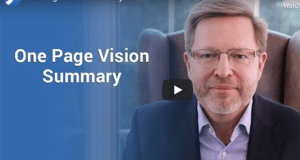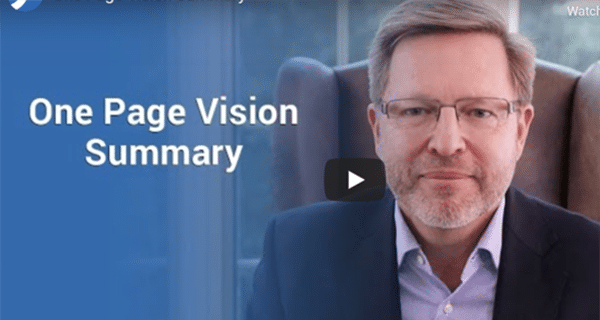 There is an object in the Pirates Of The Caribbean movies that aptly sums up what we’re going to talk about in this article — the compass. If you’re unfamiliar with the movies, the compass is a magical item of significant importance that is often overlooked. The compass doesn’t point North, it points to the object you desire — but only if you know what you desire.
There is an object in the Pirates Of The Caribbean movies that aptly sums up what we’re going to talk about in this article — the compass. If you’re unfamiliar with the movies, the compass is a magical item of significant importance that is often overlooked. The compass doesn’t point North, it points to the object you desire — but only if you know what you desire.
The One Page Vision Summary is your compass, guiding your company towards its “desires” — but first you must be clear on what those “desires” are.
The One-Page Vision Summary and why you need one
If you want everyone in the company on the same page, then you need to have A PAGE to get them on.
A good One Page Vision Strategy (OPVS) drives engagement, alignment and focus throughout the organisation. It provides a one-page format to communicate key aspects of the company’s vision, not only to employees, but to customers, investors, and the broader community as well.
Breaking down the OPVS
Check out the OPVS below (and HERE you can download a copy of the one page template to fill out) — it’s divided into three sections.
Section 1: Vision
The top part outlines the broader part of your vision and includes: Core Values, Purpose, Brand Promises, and Big, Hairy, Audacious Goal (BHAG).
If everyone in your organisation is clear on where you stand in these four areas, they’ll already be way ahead of 99% of employees in most other organisations!
If everyone in your organisation is clear on where you stand in these four areas, they’ll already be way ahead of 99% of employees in most other organisations!
Section 2: Priorities
The second section lays out your priorities, where you focus for the next quarter, year, and three to five years. With your first section in place, knowing where to focus becomes much easier.
Section 3: Objectives
Finally we come to the last section, where things are personalised to each individual employee. Based on your answers from the first two sections, have each of your employees ask themselves:
“Given our vision and priorities, how can I contribute to help the company achieve its goals — both in my ongoing job and my single priority that I’m going to focus on over the next 90 days?”
Filling out your OPVS
Can you see how having a good OPVS is critical in getting your organisation aligned and headed toward achieving your goals and scaling your business?
The OPVS is filled out from top to bottom. Scroll down to the bottom of the article and print out your copy of the OPVS and then we can work through it together.
Core Values, Purpose, Brand Promises And BHAG
“If the Core Values are the soul of the organisation, the core Purpose (some call it “mission”) gives it heart.”
Your Core Values and Purpose go hand-in-hand, and once these are in place, you can use them to define your Brand Promises. With the rest of your vision established, you can finally use that information to determine what your BHAG is going to be.
Core Values
These are the rules and boundaries that define the company’s culture and personality. They are your company’s “shoulds and shouldn’ts.”
Your organisation’s Core Values should be so well established in the company that you would be comfortable referring employees to them when faced with a tough decision or ethical dilemma.
Think of your company as a child that is still forming its values. As the child (and your company) grows, its values solidifies and define who they are. Your Core Values work the same, taking time to form fully. But as you continue to refer to and embody them, they will slowly set and define your company culture and future decisions.
Note: Don’t feel compelled to call these concepts Core Values. Call them whatever fits for you, be it, Rules, Beliefs, HP Way. The key is to figure out your values so that as you scale your business, and your team can use these values as a decision-making guide to keep your company culture strong.
Purpose
Your Purpose answers some very basic Why questions:
- Why is this company doing what it’s doing?
- What is the higher purpose?
- Why should I have passion for what we’re going?
- Why would our customers miss us if we weren’t around?
Your team needs a reason other than “making money” to feel inspired to wake up each morning and give their all.
Research finds that if you ignite and capture your team’s hearts, not just their heads, they will give you 40% more discretionary effort. Did You Know That A Core Purpose/Mission Can Increase Returns By 400 Percent!
hgAdviser’s Purpose
At hgAdvisers, we are an executive education and coaching company. Why does this matter? In the end, it’s all about freedom. It’s freeing leadership teams from the day-to-day so they can get out and grow the firm.
It’s about helping entrepreneurs, who launched a business for the freedom and independence it promised, to deal with the new constraints of their own creation.
Scale Up Growth Partners purpose is to Grow Remarkable – Leaders and Companies & to make a positive mark on the work (business, philanthropy and family).
Brand Promises
What differentiates you from your competition?
Your Brand Promises.
Write down three brand promises in this column. Your Brand Promises should be defined quantitatively so it can be measured and monitored.
They should also be meaningful. Avoid using vague words such as, “quality,” “value,” or “service” as these definitions might vary depending on the group of customers you’re facing.
Here are some examples of Brand Promises from some prominent companies:
- Rackspace: Fanatical support (answering customer calls within three rings).
- FedEx: 10am delivery.
- BMW: The ultimate driving experience.
- Walmart: Save money. Live better.
- Apple: Think different.
BHAG
Your BHAG is what anchors the three visions above. Verne Harnish talks about this extensively in his article, BHAG — Why The Most Successful Companies Set Ambitious, Long-Term Goals & Why Yours Should Too, but here is a quick summary of what it is: a BHAG is a long-term, 10 to 25-year goal, guided by your company’s Core Values and Purpose.
But it has to be a challenge so audacious and outside-the-box, that it will take a well-oiled company with everyone on-board, heading in the same direction to achieve it.
Laying out your priorities
Now that we’ve got our vision in place, we need a way to get there. This is where our strategic priorities come into play. It’s divided into three to five year goals, annual priorities and quarterly priorities. Each goal should work towards achieving your BHAG.
Recruit the smartest people in your company to advise you on what your priorities are. It is also helpful to talk to those who have experience being where you’re about to go.
Start from the first column on the left, so you work backwards.
Three to five years
These goals are significant medium-term priorities and are meant to provide a clear strategic direction for the next several years.
Your priorities don’t always have to be a new goal you have to reach, it can also sometimes be about a dramatic refocus of the core business. Look at Steve Jobs and Apple as an example.
When he became Apple’s CEO in 1997, Steve Jobs pulled Apple out of all of its current business lines and focused on producing just two desktops and two laptops. Look how far that decision has brought them today.
One year
“The main thing is to keep the main thing the main thing” — Stephen R. Covey
In this column, list your #1 Priority. While it’s tempting to have a few priorities for the year, having one overarching priority creates clarity and power throughout the organisation by laser-focusing everyone’s attention.
Along with your #1 Priority, list the Key Initiatives necessary to achieve this #1 Priority.
Quarterly
Sometimes we have semi long-term goals that we forget to celebrate. Verne Harnish talked about it briefly in his article, 10 Rockefeller Habits — The Only Framework You Need To Scale Your Business NOW, under Rockefeller Habit #2.
In this column, you set one #1 Priority. It’s a 90-day goal that helps move you towards your one-year goal. Yes, whether it’s a quarter, or a year, you should set only one priority for each time frame. You should also set the “Rocks” required to reach this goal.
Creating personal objectives
Now we come to the section where each employee can personalize the plan. Once the vision is set, sit down with each individual to help them establish what they can do to over the next 90 days to help the organisation succeed.
Here they can list a handful of key performance indicators (KPIs), priorities, and a Critical Number for the quarter. These should support and align with the company’s vision.
- Your KPIs: Every employee or team should have an ongoing KPI or two that enables them to quantifiably answer the question, “Did we have a productive day or week?”
- Your Quarterly Priorities: In addition to an individual’s ongoing work, what are a few priorities for the quarter that will raise his/her performance or drive a special project that aligns with the employee’s Critical Number and the #1 Priority of the company?
- Critical Number: What is the single most important quantifiable quarterly achievement for that person or team that will help the company achieve its vision?
Each team member will fill out this section differently, so each person should post their personal Vision Summary somewhere they will see it often, as a daily, visual reminder of your strategic plan and their part in making it a reality.
Your OPVS
So here’s the question now — does your company have a One Page Vision Summary? If you do, leave a comment and let us know how it’s working. If not, download your copy HERE and set some time aside with your leadership team (and later your employees) to fill it out. I guarantee it will make a difference!
Recommended reading:
- The Inside Advantage: The Strategy That Unlocks the Hidden Growth in Your Business by Robert H. Bloom and Dave Conti’s book
- How Companies Win: Profiting From Demand-Driven Business Models No Matter What Business You’re In by Rick Kash and David Calhoun
- Turning Goals into Results: The Power of Catalytic Mechanisms by Jim Collins


